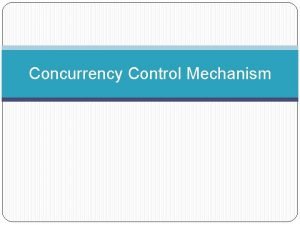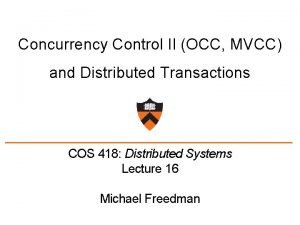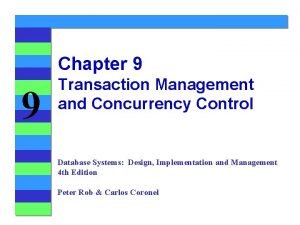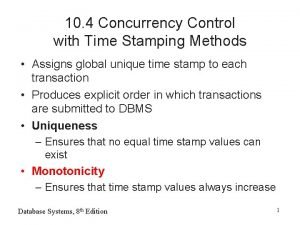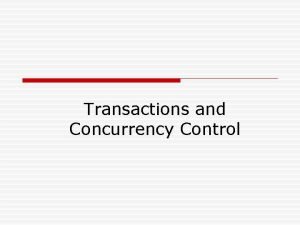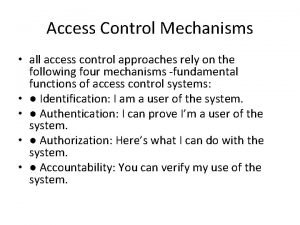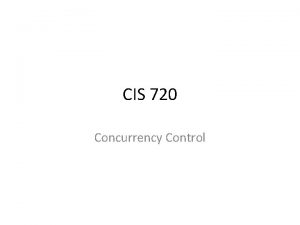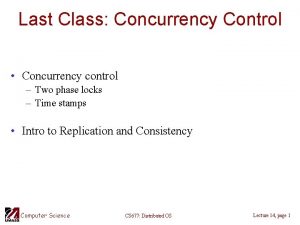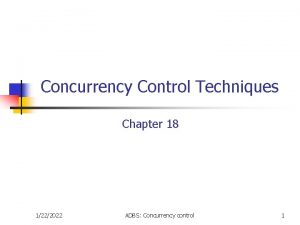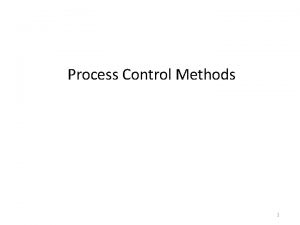Concurrency Control Mechanism What is Concurrency Control Process
























- Slides: 24

Concurrency Control Mechanism

What is Concurrency Control? �Process of managing simultaneous execution of transactions in a shared database, to ensure the serializability of transactions, is known as concurrency control.

Why we need Concurrency Control? �Simultaneous execution of transactions over a shared database can create several data integrity and consistency problems: • Lost Updates. • Uncommitted Data. • Inconsistent retrievals.

When we need Concurrency Control? �Concurrent access to data is desirable when: 1. The amount of data is sufficiently great that at any given time only fraction of the data can be in primary memory & rest should be swapped from secondary memory as needed. 2. Even if the entire database can be present in primary memory, there may be multiple processes.

Concurrency Control Techniques �Pessimistic concurrency control – Locking �Optimistic concurrency control

Pessimistic Concurrency Control • Pessimistic Concurrency Control assumes that conflicts will happen • Pessimistic Concurrency Control techniques detect conflicts as soon as they occur and resolve them using blocking.

Optimistic Concurrency Control • Optimistic Concurrency Control assumes that conflicts between transactions are rare. • Does not require locking • Transaction executed without restrictions • Check for conflicts just before commit

Lock-Based Protocols �A lock is a mechanism to control concurrent access to a data item �Data items can be locked in two modes : �Exclusive lock �Shared lock

Lock-Based Protocols � Exclusive (X) mode. Data item can be both read as well as written. X-lock is requested using lock-X instruction. � Shared (S) mode. Data item can only be read. S-lock is requested using lock-S instruction

Lock-Based Protocols �Lock-compatibility matrix

Lock-Based Protocols �A transaction may be granted a lock on an item if the requested lock is compatible with locks already held on the item by other transactions �Any number of transactions can hold shared locks on an item, but if any transaction holds an exclusive on the item no other transaction may hold any lock on the item. �If a lock cannot be granted, the requesting transaction is made to wait till all incompatible locks held by other transactions have been released. The lock is then granted

Lock-Based Protocols �Example of a transaction performing locking: T 2: lock-S(A); read (A); unlock(A); lock-S(B); read (B); unlock(B); display(A+B)

Lock-Based Protocols �A locking protocol is a set of rules followed by all transactions while requesting and releasing locks. Locking protocols restrict the set of possible schedules.

Pitfalls of Lock-Based Protocols �Consider the partial schedule

Pitfalls of Lock-Based Protocols � Neither T 3 nor T 4 can make progress — executing lock-S(B) causes T 4 to wait for T 3 to release its lock on B, while executing lock-X(A) causes T 3 to wait for T 4 to release its lock on A. � Such a situation is called a deadlock. �To handle a deadlock one of T 3 or T 4 must be rolled back and its locks released.

Pitfalls of Lock-Based Protocols �The potential for deadlock exists in most locking protocols. Deadlocks are a necessary evil. �Starvation is also possible if concurrency control manager is badly designed. For example: �A transaction may be waiting for an X-lock on an item, while a sequence of other transactions request and are granted an S-lock on the same item. �The same transaction is repeatedly rolled back due to deadlocks. �Concurrency control manager can be designed to prevent starvation.

The Two-Phase Locking Protocol � This is a protocol which ensures conflict-serializable schedules. � Phase 1: Growing Phase �transaction may obtain locks �transaction may not release locks � Phase 2: Shrinking Phase �transaction may release locks �transaction may not obtain locks � The protocol assures serializability. It can be proved that the transactions can be serialized in the order of their lock points.

The Two-Phase Locking Protocol �Two-phase locking does not ensure freedom from deadlocks �Cascading roll-back is possible under two-phase locking. To avoid this, follow a modified protocol called strict two-phase locking. Here a transaction must hold all its exclusive locks till it commits/aborts. �Rigorous two-phase locking is even stricter: here all locks are held till commit/abort. In this protocol transactions can be serialized in the order in which they commit.

Lock Conversions � Two-phase locking with lock conversions: – First Phase: �can acquire a lock-S on item �can acquire a lock-X on item �can convert a lock-S to a lock-X (upgrade) – Second Phase: �can release a lock-S �can release a lock-X �can convert a lock-X to a lock-S (downgrade) � This protocol assures serializability. But still relies on the programmer to insert the various locking instructions.

Automatic Acquisition of Locks � A transaction Ti issues the standard read/write instruction, without explicit locking calls. � The operation read(D) is processed as: if Ti has a lock on D then read(D) else begin if necessary wait until no other transaction has a lock-X on D grant Ti a lock-S on D; read(D) end

Automatic Acquisition of Locks � write(D) is processed as: if Ti has a lock-X on D then write(D) else begin if necessary wait until no other trans. has any lock on D, if Ti has a lock-S on D then upgrade lock on D to lock-X else grant Ti a lock-X on D write(D) end; � All locks are released after commit or abort

Implementation of Locking �A Lock manager can be implemented as a separate process to which transactions send lock and unlock requests �The lock manager replies to a lock request by sending a lock grant messages (or a message asking the transaction to roll back, in case of a deadlock) �The requesting transaction waits until its request is answered

Implementation of Locking �The lock manager maintains a data structure called a lock table to record granted locks and pending requests �The lock table is usually implemented as an inmemory hash table indexed on the name of the data item being locked

Lock Table � Black rectangles indicate granted � � locks, white ones indicate waiting requests Lock table also records the type of lock granted or requested New request is added to the end of the queue of requests for the data item, and granted if it is compatible with all earlier locks Unlock requests result in the request being deleted, and later requests are checked to see if they can now be granted If transaction aborts, all waiting or granted requests of the transaction are deleted � lock manager may keep a list of locks held by each transaction, to implement this efficiently
 Concurrency control mechanisms
Concurrency control mechanisms Concurrency control and recovery in database systems
Concurrency control and recovery in database systems Concurrency control and recovery
Concurrency control and recovery Concurrency control in distributed databases
Concurrency control in distributed databases Concurrency control in distributed transactions
Concurrency control in distributed transactions Transactions and concurrency control in distributed systems
Transactions and concurrency control in distributed systems Transaction management and concurrency control in dbms
Transaction management and concurrency control in dbms Time stamping in database
Time stamping in database Microsoft flow concurrency control
Microsoft flow concurrency control Timestamp based concurrency control
Timestamp based concurrency control Locks in dbms
Locks in dbms On optimistic methods for concurrency control
On optimistic methods for concurrency control Transaction management and concurrency control
Transaction management and concurrency control Product and process control
Product and process control Alkene dimerization
Alkene dimerization Access control mechanisms
Access control mechanisms Internal control mechanism
Internal control mechanism Negative feedback homeostasis
Negative feedback homeostasis Tcp flow control sliding window
Tcp flow control sliding window Point of concurrency geometry
Point of concurrency geometry Orthocenter practice problems
Orthocenter practice problems Concurrency in web applications
Concurrency in web applications Altitude concurrency conjecture
Altitude concurrency conjecture Concurrency & parallelism in ue4
Concurrency & parallelism in ue4 Unix concurrency mechanisms
Unix concurrency mechanisms
